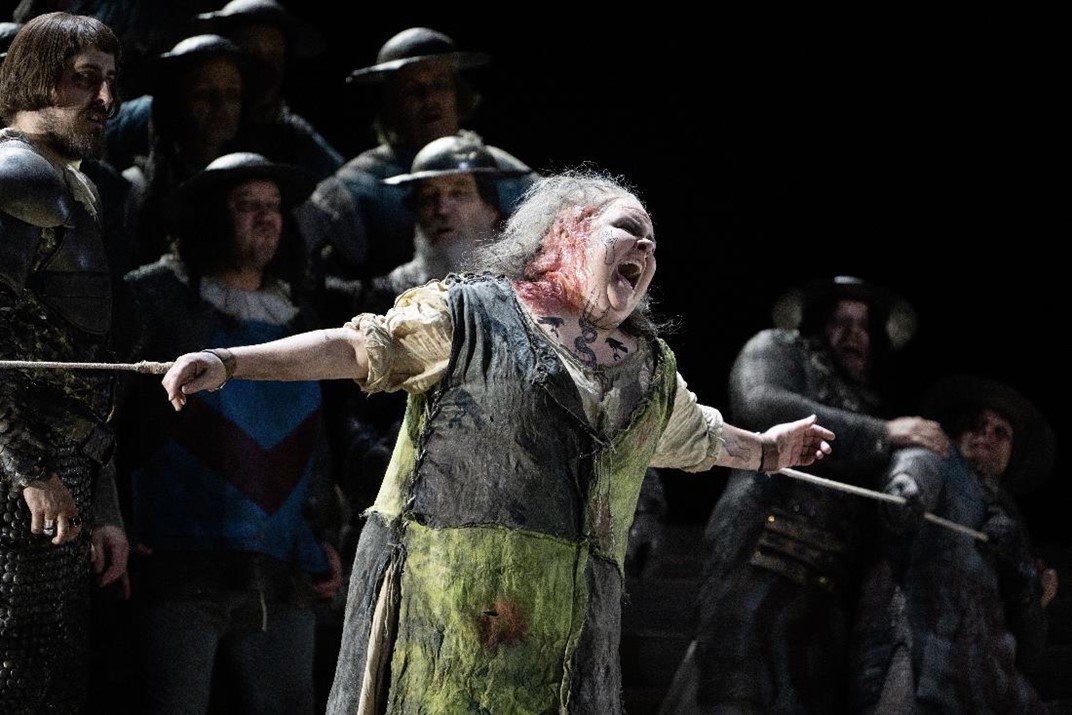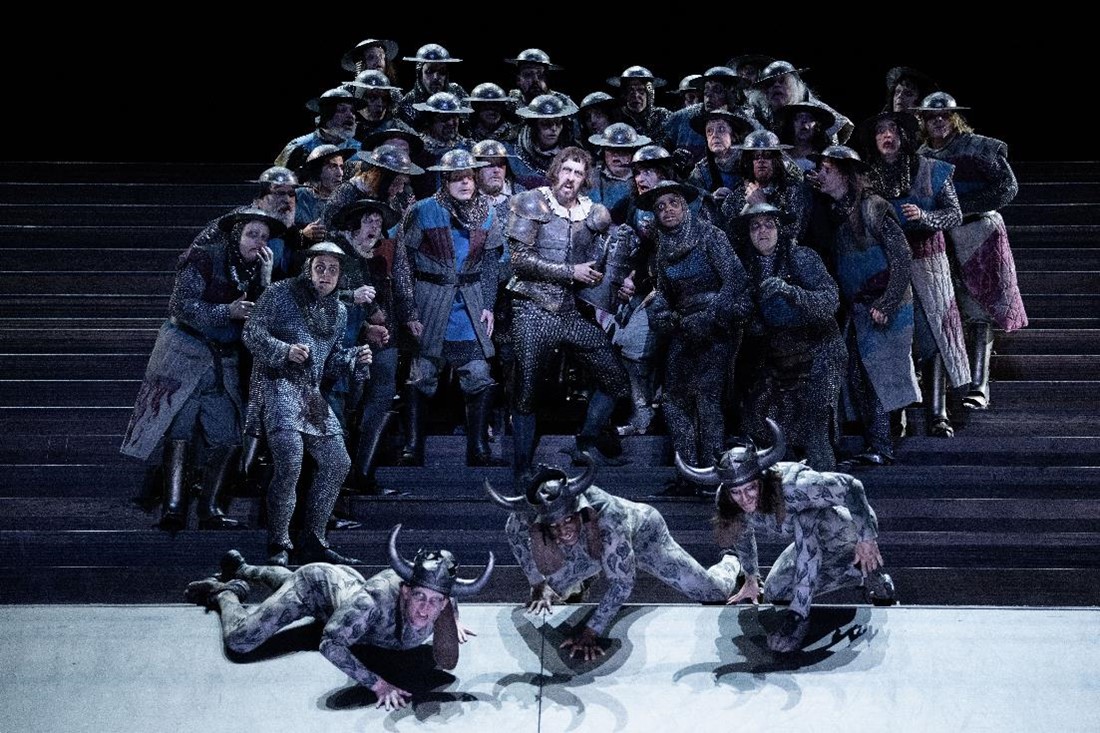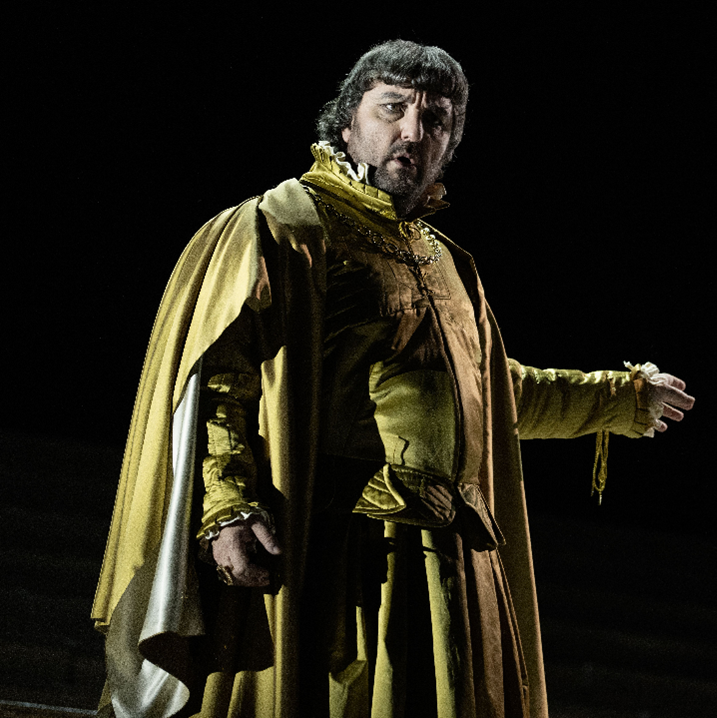Reviews
New ROH Trovatore Loses Its Way
LONDON—The years 1851-53 found Verdi in a hot vein of inspiration. Rigoletto and La traviata are indelible masterpieces in which Bel Canto and ardent romance merge into a potent mode of operatic expression; but what of Il trovatore? Once as popular as the other two, in recent years it has slipped down the Verdi charts, outstripped in public affection by big beasts like Don Carlo and Otello.
The problem with Il trovatore is not the score—it brims with earworms and gorgeous set pieces—but the libretto by Salvatore Cammarano that spins a tale so ungainly he devotes long, verbose chunks of Acts 1 and 2 to unpicking its backstory. Nowadays, at a time when dramatic truth carries almost as much weight as musical performance, the opera is a mess of theatrical potholes waiting to trip up the unwary director.

Jamie Barton gives a "sensational account" of Azecuna in ROH's new Il trovatore
It certainly brought Adele Thomas up short in her new production for The Royal Opera, opening June 2. The gifted Welsh director is adept at intimate opera, as she proved with her Olivier Award-winning account of Vivaldi’s Bajazet at the same address (staged in the pocket-sized Linbury Theatre), while her imaginative realization of four Handel cantatas earlier this year confirmed her to be skilled at helping singers build interpretations. However, the sheer scale of Il trovatore presented her with a new test and she has fallen short.
The crux of the problem is manifest in designer Annemarie Woods’s’ vast staircase that spans the entre width and depth of the ROH stage. The characters weave their way across it in confusing tableaux inspired, so the program note suggests, by the infernal art of 15th-century painter Heironymus Bosch. In consequence it can be hard to identify who’s who, who’s on whose side, and what psychological need drives their physical momentum.
On a smaller stage and with half the number of stairs, Thomas’s concept might have held the attention. As it was, she misjudged the challenge that epic grand opera presents to a director. The muddle was compounded by her reluctance to bring the singers downstage where they could be seen and heard clearly; instead, she favored the upper reaches of the staircase, away from the audience, so that witnessed from the rear of the auditorium, both sight and sound were conspicuously diminished.
 There were further impediments: Pity the unsuspecting patrons seated to the left or right of the horseshoe auditorium, for whom Thomas’s imposition of a giant picture frame in front of the stage has left whole swathes of the action invisible. Perhaps the director never left her optimum-view seat in the center stalls when rehearsing her work.
There were further impediments: Pity the unsuspecting patrons seated to the left or right of the horseshoe auditorium, for whom Thomas’s imposition of a giant picture frame in front of the stage has left whole swathes of the action invisible. Perhaps the director never left her optimum-view seat in the center stalls when rehearsing her work.
The Royal Opera Chorus has achieved great things under its American director, William Spaulding, and musically it has never sounded better than in his rousing account of the Anvil Chorus. The music as a whole soared under the baton of Antonio Pappano, with lustrous performances all round and a sensational account of the witch-like Azecuna from Jamie Barton, her low notes chilling in their intensity and her assumption of a potentially ridiculous role bristling with dramatic conviction. She even eclipsed her co-leads Riccardo Massi (Manrico), Marina Rebeka (Leonora), and Ludovic Tézier (the Count di Luna), notwithstanding their fine performances.
A personable Ferrando (Italian bass Roberto Tagliavini, stirring in both idiom and timbre) dominated Act 1 with his text-heavy exposition. His exhortation “All’erta!” caught the attention as it should, prompting a swarm of the Count’s soldiers to engulf him, clinging to every word, while anthropomorphic man-animals nuzzled round him in lithe choreography by Emma Woods. Restless and urgent, Tagliavini related half the story of the titular troubadour to his dutiful listeners but left it to Barton’s Azecuna to give the tale its twist later on.
 For all the sound and fury, at its heart Il trovatore is a standard Verdian love triangle of soprano (pure), tenor (heroic), and baritone (dastardly). There is death, of course, but it never seems to hurt and tends to be welcomed by the doomed lovers, while the villain suffers no reckoning heavier than a spot of regret. Such melodramatic hokum is ripe for parody and fails to maintain the characters’ dignity in her quest for a pleasing image. It was a strange idea to clothe Tézier’s Count according to the Henry VIII paradigm—broad of stance and stout of frame beneath a childish pageboy bob—a silly physiognomy that not even the venerable French baritone could entirely overcome. This di Luna was more a brat than a tyrant.
For all the sound and fury, at its heart Il trovatore is a standard Verdian love triangle of soprano (pure), tenor (heroic), and baritone (dastardly). There is death, of course, but it never seems to hurt and tends to be welcomed by the doomed lovers, while the villain suffers no reckoning heavier than a spot of regret. Such melodramatic hokum is ripe for parody and fails to maintain the characters’ dignity in her quest for a pleasing image. It was a strange idea to clothe Tézier’s Count according to the Henry VIII paradigm—broad of stance and stout of frame beneath a childish pageboy bob—a silly physiognomy that not even the venerable French baritone could entirely overcome. This di Luna was more a brat than a tyrant.
The doomed lovers were better served by the director with Rebeka, sole survivor from the production’s debut outing in Zurich, an especially radiant presence. Her voice had a silvery gleam that helped establish the essence of Leonora’s goodness and complemented the ardour of Massi’s self-absorbed Manrico, the lover who languishes so romantically in his desire for death.
Photos upper left: Roberto Tagliavini as Ferrando, engulfed by the Count’s soldiers and anthropomorphic man-animals; bottom right: Ludovic Tézier as the Count di Luna.
Photos by Camilla Greenwell
Classical music coverage on Musical America is supported in part by a grant from the Rubin Institute for Music Criticism, the San Francisco Conservatory of Music, and the Ann and Gordon Getty Foundation. Musical America makes all editorial decisions.

WHO'S BLOGGING

Law and Disorder by GG Arts Law
Career Advice by Legendary Manager Edna Landau
An American in Paris by Frank Cadenhead





 FEATURED JOBS
FEATURED JOBS

 RENT A PHOTO
RENT A PHOTO


